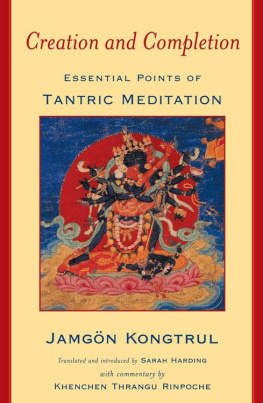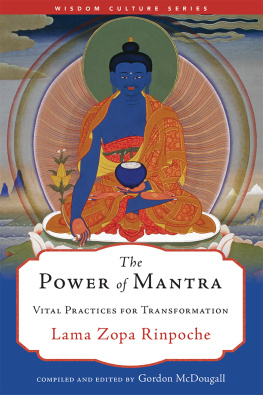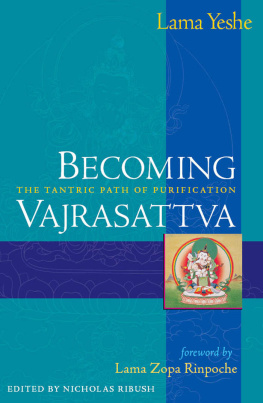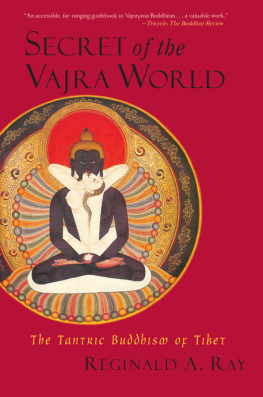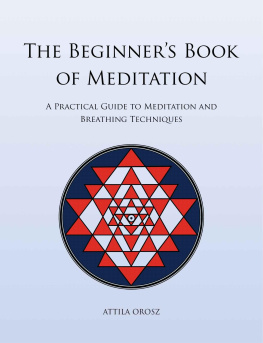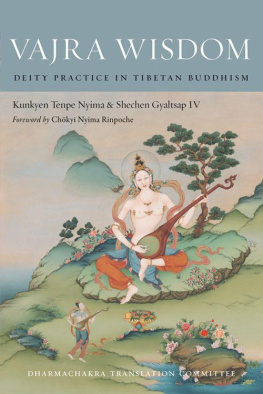V AJRASATTVA M EDITATION

W ALK STEP BY STEP THROUGH THE STAGES OF THIS TANTRIC RITUAL OF PURIFICATION WITH INSPIRED COMMENTARY AND FULL-COLOR ILLUSTRATIONS .
T he force of our past actions makes it hard to attain our goals, including success in meditation. Buddhism has developed methods for purifying our past, clearing the obstacles to success and fulfillment. One of the most popular methods for karmic housekeeping, common to all schools of Tibetan Buddhism, is the preparatory practice of visualizing the buddha Vajrasattva and reciting his hundred-syllable mantra. It is considered an essential foundation for the success of spiritual endeavor, enhancing our capacity for concentration, emotional freedom, and profound realization.
Combining prayers, visualizations, mantras, and multiple styles of meditation, the practice of Vajrsattva meditation is an entryway into the performance of the complex tantric sadhana rituals that are central to Tibetan Buddhism. Accompanied by more than forty color illustrations, this friendly volume is the perfect practical guide for both beginners and experienced practitioners.

KHENPO YESHE PHUNTSOK was born in 1971 and trained at Larung Gar Buddhist Institute in Serthar, Tibet, where he is now a senior teacher. He has been a major figure in the spread of Tibetan Buddhism among Chinese speakers worldwide. This is his first book in English.
C ONTENTS
Namo Guru Vajrasattva!
I F WE EXAMINE all that we know of human history, it is rare to find a time of happiness and certainty. As human beings, we suffer from what we cannot avoidfrom death and old age and the grief of losing our loved ones. More frequently, though, we suffer from what we do not avoid. That is, we suffer because we do not refrain from deeply ingrained habits of harmful thoughts, unhelpful speech, and acts driven by our negative emotions.
How often have we wished to let go of all those regrettable actions and painful memories and be more positive, more generous, and more at ease? We understand that our past actions, and the imprints they have left on our psyche, haunt us, making happiness and fulfillment difficult. We search for a spiritual path to alleviate our pain and to fulfill this wish to be free. Yet even when we enter into a spiritual practice, we find we are still weighed down by all our habits and fears, and progress toward contentment, compassion, and wisdom is slow.
Fortunately for us, there are methods on the spiritual path to address our predicament and accelerate our progress. Buddha Samantabhadra said in the Great Perfection tantras that it is at times of strife and degradation that Vajrasattva Buddha is able to widely liberate sentient beings. Given the state of our environment, economy, and politics in this day and age, Vajrasattva purification meditation is the most potent method for removing the cancer that is our painful actions, memories, and habits.
I compiled this book according to many Buddhist scriptures so that practitioners could correctly visualize and properly generate the essential elements for purification. In particular, this book follows the meditational liturgy called The Precious Wish-Fulfilling Bead: A Vajrasattva Sadhana, translated and adapted for the present work. This text was a revelation, or mind terma, of my root guru, the great khenpo and Dharma king Jigme Phuntsok Rinpoche. Unlike most treasure texts, this one can be practiced even without an empowerment.
Mind termas such as this one appear only rarely and only to those who have already purified their mind to great depths. Such treasure revealers are like buddhas living among us. Jigme Phuntsok Rinpoche was such a presence. I am ever indebted to him, and the more I learn, the more my reverence and gratitude for his teachings increases. A brief presentation of his life and accomplishments can be found in the back of this book.
I originally compiled this book in Chinese when there were already many Chinese Buddhists diligently practicing this liturgy. The number of mantra recitations reported to me by those practitioners was staggering, and the enthusiasm for the practice was undeniable. My goal was to enhance the quality of the practice. To that end, I created this step-by-step guide with pictures for the entire liturgy along with explanations of the process of purification and tips for purifying each of the most serious misdeeds and common nonvirtues. It later became clear that there were no books of this kind in English, despite the plethora of books on tantra and Buddhism in general. To fill this void and to bring this incredibly fast and thorough method for righting past wrongs to more people, I sought to have this book made available in English as well.
My ardent wish is that this book will benefit all who come across it with the means to create greater happiness, peace, harmony, and compassion. May all be auspicious and of great benefit to all beings!
Khenpo Yeshe Phuntsok
Larung Gar Buddhist Institute, 2014
W HILE ALL THE MANY METHODS that the Buddha taught are valid, when it comes to our individual needs, we need the approach that best suits our temperament. Many have found the tantric method well suited to contemporary times. The modern world has many multitaskers, who are not only capable but even addicted to accomplishing more than one thing at a time. For those whose hands, eyes, thought, and speech all seek activity simultaneously, who do not try to be totally immersed in one activity but rather are totally preoccupied with many, the tantric approach makes a lot of sense. With tantra we capitalize on this habit of multitasking. Our hands twirl the 108 beads of the mala rosary. Our eyes may rest on the images of the buddhas we seek to become. Our thoughts visualize and contemplate the image of the buddha we are looking at, bringing it into our space and time. Our vocal chords vibrate with Sanskrit syllables that activate our subtle nervous system. Moreover, with the tantric approach we find buddhas tailored to different needs: for instance, Medicine Buddha for when we are sick, wealth deities for when we are penniless, wrathful deities for when we are overwhelmed by anger or fear.
In this text we focus on the practice of Vajrasattva, the buddha of purification, who diminishes the obscurations and negativity that keep us from receiving the insights of the Buddha. Visualization is central to the tantric approach, and this book helps refine our vision of the deity. Vajrasattva is generally white in color. Royal and majestic, he wears a crown, silks, and jewels. He sits cross-legged on a grand lotus throne. Resplendent with light, like a thousand suns, his body is present, but there is nothing solid or opaque about him; he is not a human with bone and tissue. His form is like a rainbowpresent and clear, but ungraspable. He radiates compassion and wisdom. The heart of this book explains and shows in great detail his form and attributes.
This book is for Buddhist practitioners, particularly those who have had an introduction to the Vajrasattva practice from a qualified teacher and are looking to perform a sadhana, or meditational liturgy, of Vajrasattva. Normally a practitioner needs an empowerment or initiation to visualize tantric deities. The unique quality of the sadhana in this book is that it does not require such an empowerment. Nonetheless, a Vajrasattva initiation would increase the strength of the practitioners connection and commitment.
In Vajrasattva practice, meditators typically visualize Vajrasattva and his purifying power entering and washing through them in the form of white nectar while they recite a hundred-syllable mantra. This light clears away the accumulation of negative karma and creates a foundation for the path to enlightenment. Eventually, through this purifying light, they may become indivisible from Vajrasattva himself, which is to say, fully enlightened. In the particular liturgy illustrated in this book, the
Next page


